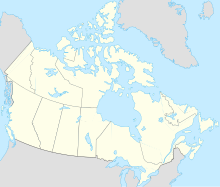Large Zenith Telescope
The Large Zenith Telescope (LZT) is a reflecting telescope with a diameter of 6 m, which - due to the primary mirror made of liquid mercury ( liquid mirror , liquid mirror telescope ) - is aimed exclusively at the zenith and is therefore also classified in the category of zenith telescopes . Its location is 395 m above sea level in the Malcolm Knapp Research Forest of the University of British Columbia , about 70 km east of Vancouver . Completion was in 2003; the scientific work started in 2004.
Liquid mirror
The primary mirror of the LZT consists of liquid mercury . This is located in an evenly rotating bowl, so that the interaction of centrifugal force and weight gives it an almost perfect parabolic shape .
The shell is guided with an air bearing for the lowest possible vibration possible ; it is driven by a brushless electric motor integrated in the air bearing . The speed of rotation is recorded by an optical encoder and kept constant by a control circuit . To keep the mercury surface away from the effects of air currents, the mirror is covered with a thin mylar sheet.
properties
Correction optics and detector are mounted directly above the mirror in the primary focus. With its focal length of only ten meters, the device has a very large focal ratio of 1: 1.5.
This alleviates the central disadvantage of a zenithoscope that only a thin strip of the sky can be observed. The corrected field of view has an opening angle of 24 arc minutes , the camera 17 '. By synchronously moving the image recorder against the rotation of the earth , longer exposure times (max. 24-17 = approx. 7 min) are made possible.
However, concepts have been developed to expand the possible image field in a range of up to ± 23 ° by using movable and possibly deformable secondary and tertiary mirrors. This would also make it possible to observe several regions of the sky at the same time.
Web links
- Homepage of the Large Zenith Telescope (eng.)
- EF Borra, G. Moretto, M. Wang: An optical corrector design that allows a fixed telescope to access a large Region of the sky (PDF; 153 kB), 1994 (eng.)
- Professional Instruments Company: Liquid Mirror Telescope - Slideshow

